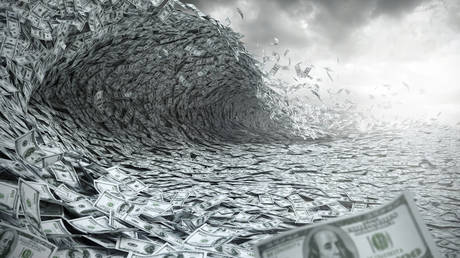The Fed Has 233 Secret Documents about JPMorgan’s Potential Role in the Repo Loan Crisis
by Pam Martens and Russ Martens, Wall St On Parade:

The Federal Reserve Board of Governors has acknowledged to Wall Street On Parade that it has 233 documents that might shed some light on why JPMorgan Chase was allowed by the Fed to draw down $158 billion of the reserves it held at the Fed last year, creating a liquidity crisis in the overnight loan market according to sources on Wall Street. After taking four months to respond to what should have been a 20-business day turnaround on our Freedom of Information Act request, the Federal Reserve denied our FOIA in its entirety. (Our earlier request to the New York Fed resulted in the same kind of stonewalling. See The New York Fed Is Keeping JPMorgan’s Secrets Close to Its Chest.)
The Wall Street liquidity crisis forced the Federal Reserve, beginning on September 17 of last year, to begin making tens of billions of dollars in loans each business day to the trading houses on Wall Street. It calls these firms its “primary dealers” since they also engage in open market operations with the Fed and are under contract with the government to make purchases of Treasury securities during Treasury auctions, a dangerous symbiotic relationship to say the least. This was the first time since the financial crisis of 2008 that the Fed had made these so-called repo loans to the trading houses on Wall Street.
On September 17, the word “coronavirus” was unknown to most people around the world. The spread of the virus in China did not begin to make news until January of this year. Thus, the roots of the liquidity crisis on Wall Street cannot be assigned to the coronavirus, although we have every expectation that Wall Street and its minions will make every effort to do so as the history of this crisis is written – no doubt with the aid of Andrew Ross Sorkin and Paul Krugman of the New York Times.
The first coronavirus case in the U.S. to be confirmed by the Centers for Disease Control and Prevention (CDC) was reported by CNN on January 22 of this year. It had been confirmed by the CDC on January 21. But the Fed’s repo loan money spigot by that time had already pumped out $6 trillion in cumulative repo loans to the trading houses on Wall Street. And the dollar amounts of its emergency loans kept rising, as evidenced by the ongoing official statements that the New York Fed published on its website.
On October 4, the Fed announced that it was extending what was supposed to be a short-term, temporary loan program into November, as we reported that Wall Street mega banks had announced 68,000 in job cuts. Again, that was long before any coronavirus problem.
On October 23, 2019, before there was any hint of a coronavirus problem anywhere in the world, the New York Fed announced a massive expansion of its loans to Wall Street. It said it would be funneling up to $120 billion a day in cheap overnight loans to Wall Street trading firms, a daily increase of $45 billion from its previously announced $75 billion a day. In addition, it said it would increase its twice-weekly 14-day term loans to Wall Street from $35 billion to $45 billion. That would bring the weekly offerings up to a potential $690 billion a week. We noted at the time that if the Wall Street firms were getting these loans rolled over and over, as they did during the Fed’s bailout in 2008, they are effectively permanent loans at unprecedented low interest rates for firms that are far from AAA credits. To derive a windfall from these loans, all the trading firms would have to do is borrow from the Fed at 1.50 percent and make margin loans to stock traders at 7 or 8 percent.
We knew from the New York Fed’s unprecedented $29 trillion money spigot to the Wall Street trading firms during the 2008 financial crisis that this was going to eventually turn into a full scale bailout of the latest bubble on Wall Street, just as it had in 2008. And because the mainstream media was ignoring the story, we took it upon ourselves to chronicle the Fed’s repo loan activities in more than five dozen articles which we have archived for our readers here.
The Fed’s money spigot became a gusher this week. On Wednesday, the New York Fed announced that it would be making up to $270 billion, in just one day, available to Wall Street on Thursday. But before Thursday was over, the Fed upped its largess to such a staggering figure that even we were speechless. It said that between Thursday and today, it would offer $1.5 trillion in a combination of 3-month and one-month loans – on top of its other ongoing loan programs.
The stunning sum of $1.5 trillion exceeds the $1.433 trillion the Fed had outstanding in emergency loans to Wall Street trading firms and banks at the peak of the crisis in 2008, according to the audit performed by the Government Accountability Office.
Strangely, however, after tapping $198.1 billion from the Fed’s other loan offerings in the morning yesterday, Wall Street firms only tapped $78.4 billion from the giant $500 billion 3-month loan made available by the Fed in the afternoon. Wall Street seemed to interpret that as a sign that those trading firms that are in trouble didn’t have enough government-backed collateral to post for the Fed loans and the stock market closed at the lows of the day, with the Dow Jones Industrial Average selling off by 2,352 points.
Read More @ WallStOnParade.com
Loading...



